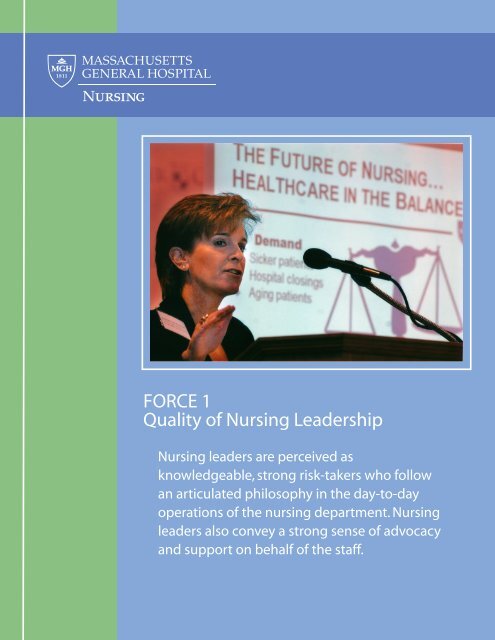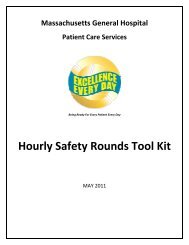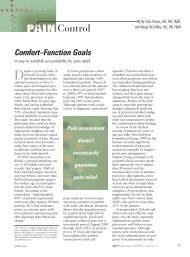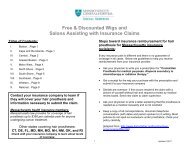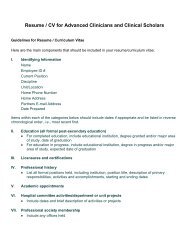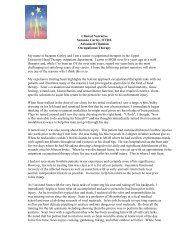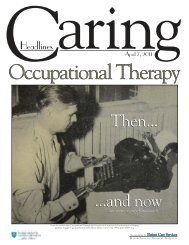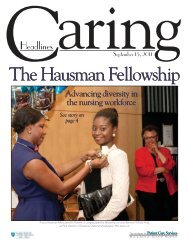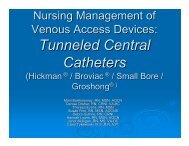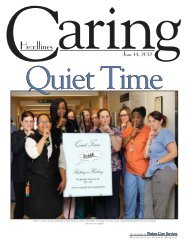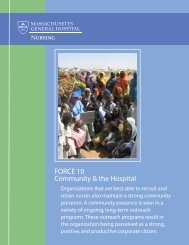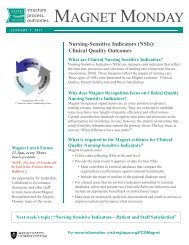Force 1: Quality of Nursing Leadership - Mghpcs.org
Force 1: Quality of Nursing Leadership - Mghpcs.org
Force 1: Quality of Nursing Leadership - Mghpcs.org
Create successful ePaper yourself
Turn your PDF publications into a flip-book with our unique Google optimized e-Paper software.
FORCE 1<strong>Quality</strong> <strong>of</strong> <strong>Nursing</strong> <strong>Leadership</strong><strong>Nursing</strong> leaders are perceived asknowledgeable, strong risk-takers who followan articulated philosophy in the day-to-dayoperations <strong>of</strong> the nursing department. <strong>Nursing</strong>leaders also convey a strong sense <strong>of</strong> advocacyand support on behalf <strong>of</strong> the staff.
EXECUTIVE SUMMARY FORCE 1: QUALITY OF NURSING LEADERSHIP<strong>Nursing</strong> leaders are perceived as knowledgeable, strong risk-takers who follow anarticulated philosophy in the day to day operations <strong>of</strong> the nursing department. <strong>Nursing</strong>leaders also convey a strong sense <strong>of</strong> advocacy and support on behalf <strong>of</strong> the staff.Under the visionary leadership <strong>of</strong> the Senior Vice President for Patient Care Services andChief Nurse, The Massachusetts General Hospital (MGH) has created a pr<strong>of</strong>essional practiceenvironment that supports growth and development <strong>of</strong> nursing staff through its excellence innursing services. To accomplish this, the Chief Nurse is visible in the highest governing bodies <strong>of</strong>the <strong>org</strong>anization strategically situated to influence decisions that impact nursing and patient caredelivery. Committed and talented nursing leadership is also essential to this success. Whether at anexecutive or unit-based level, leaders are expected to, “…challenge the process; inspire a sharedvision; enable others to act; model the way; encourage the heart” (Kouzes and Posner), an adoptedphilosophy <strong>of</strong> leadership within Patient Care Services.The Patient Care Services (PCS) Vision, Guiding Principles, <strong>Nursing</strong> Philosophy, StrategicPlan and Pr<strong>of</strong>essional Practice Model have been carefully designed to be congruent with thehospital’s four-pronged mission <strong>of</strong> practice, education, research and community. Members <strong>of</strong> thePatient Care Services Executive Team crafted these documents, seeking input from managers anddirect care staff. With this framework, a Patient Care Delivery Model was also articulated ––interdisciplinary patient- and family-centered care. The nine components <strong>of</strong> the PCS Pr<strong>of</strong>essionalPractice Model were revised ten years after its original design to include: vision and values; standards<strong>of</strong> practice; narrative culture; pr<strong>of</strong>essional development; patient-centeredness; clinical recognitionand advancement; collaborative decision-making; research; and innovation and entrepreneurialteamwork. Collaborative decision-making, operationalized as Collaborative Governance, givesdirect care staff a prominent voice in the <strong>org</strong>anization in decisions that impact their practice andquality <strong>of</strong> work-life. The development <strong>of</strong> the Clinical Recognition Program embodies the MGHnarrative culture and creates opportunities for pr<strong>of</strong>essional recognition and growth. Examplesprovided reflect nurse leader’s ability to successfully articulate patient and staff needs and secure theappropriate fiscal and human resources.Retreats with PCS Executive Team, <strong>Nursing</strong> Directors and members <strong>of</strong> the CollaborativeGovernance Committees were the primary interactive strategy for creating and disseminatinginformation about the Vision, Guiding Principles, <strong>Nursing</strong> Philosophy, Pr<strong>of</strong>essional Practice Modeland Strategic Plan. Patient Care Services and Hospital publications such as Caring Headlines,
Hotline, PCS News You Can Use; as well as Hospital, Departmental and Unit Committees, staffmeetings and conferences broaden the audience and reinforce messages about patient care. Thebudget process and resulting reports in combination with the quality dashboard provide vitaloperational, clinical, staff and fiscal information for leaders to make informed decisions. Examplesare imbedded throughout the <strong>Force</strong>.Enculturation <strong>of</strong> the values <strong>of</strong> the <strong>org</strong>anization are most aptly reflected in the MGHPatient Care Services evaluation <strong>of</strong> nurse satisfaction through the Staff Perceptions <strong>of</strong> thePr<strong>of</strong>essional Practice Environment Survey (SPPPE), administered every 12 - 18 months since 1999.In 2006, 92% <strong>of</strong> the nursing staff respondents reported being satisfied or very satisfied with thepr<strong>of</strong>essional practice environment at MGH. The high degree <strong>of</strong> participation in the CollaborativeGovernance Committees from within and outside <strong>of</strong> the Department <strong>of</strong> <strong>Nursing</strong> has contributed tothe staff satisfaction and the <strong>org</strong>anization’s success. Decisions about staffing and resources reside atthe unit level, closest to the staff and the patients. Nurses at all levels are committed and engaged inpr<strong>of</strong>essional growth and development with nurses at MGH belonging to more than 60 differentpr<strong>of</strong>essional <strong>org</strong>anizations.
TABLE OF CONTENTSVolume 1<strong>Force</strong> 1: <strong>Quality</strong> <strong>of</strong> <strong>Nursing</strong> <strong>Leadership</strong>Sources <strong>of</strong> Evidence1.11.21.31.41.51.61.71.8Pages 1-10Pages 11-28Pages 29-40Pages 41-55Pages 56-69Pages 70-84Pages 85-96Pages 97-149


